



Suggested Citation: Sharma, Mohit, Kangkanika Neog, Rudresh Kumar Sugam, and Aditya Ramji. 2016. Decentralised Waste Management in Indian Railways. New Delhi: Council on Energy, Environment and Water.
This issue brief examines opportunities for the deployment of decentralised infrastructure to manage the India Railways’ waste in a sustainable manner. It emphasises the regulatory compliances required for water use and water quality standard in order to prevent environmental damage. Further, it provides recommendations to leverage a waste management system in the Indian Railways.
Characterisation of Solid Waste used for Estimating Waste Management and WtE Potential at Railway Stations

Source: CPCB 2009
The Indian Railways (IR) is the third largest rail network in the world with 66,000 route kilometres. Running close to 21,000 passenger and freight trains daily, it catered to more than 8 billion passengers in 2015-16, providing transportation services of 1147 billion passenger-km (IR 2015a). The railways passengers’ base grew from 3.6 billion to 8.2 billion in last four decades at an average rate of 4% per annum (Figure 1).
Figure 1. Near-Term Projections for Growth in Railway’s Passenger Base
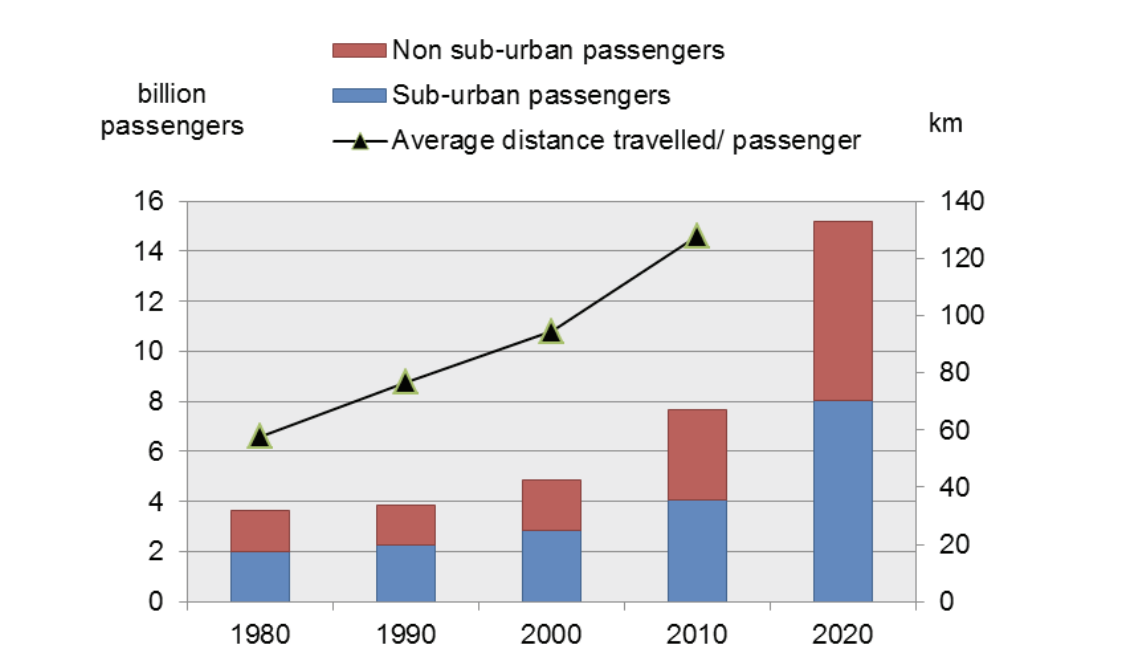
Source: Indian Railways Statistics 2015
Suburban passengers also contribute signifi cantly to the overall passenger traffi c in IR (Figure 1). It can also be seen from Figure 1 that the passenger base of IR is projected to double in the year 2020 as compared to 2011. While the Railways is one of the most economical and environment friendly modes of transport, one of the key steps in taking the railways towards a sustainable transport network is that of waste management. Waste (solid waste and wastewater) management forms an important aspect of the Railways’ strategy to improve the quality of its transportation services. Apart from catering to passenger and freight movement, the Railways also has large residential colonies for its employees, at various locations across its network. Together, across both traction and non-traction operations of the railways, they consume signifi cant resources as well as generate a significant amount of waste.
Recognising these concerns, the IR has taken several initiatives in the past few years to improve its waste management practices. This includes management of solid waste, sanitary waste and wastewater onboard moving trains and at railway stations. IR is a major user of water for cleaning at stations and generates a huge quantity of sewage in moving trains and at train stations (PAC 2014).
In his first budget speech in February 2015, Hon’ble Minister for Railways, Shri Suresh Prabhu announced the setting up of ‘waste to energy’ conversion plants near major coaching terminals to dispose waste in an environmentally-friendly manner as well as increasing the coverage of stations under the Adarsh Station Scheme and expanding the coverage of bio-toilets in collaboration with the Research Design and Standards Organisation (RDSO).
The Indian Railways has installed a waste to energy (WtE) plant for biodegradable waste in its residential colony at Kishanganj in Delhi and has plans to build two more WtE projects at New Delhi and Jaipur railway stations. Kishanganj WtE plant has a capacity to process one tonne of biodegradable waste daily and produce 70-80 units of electricity, which is being utilised for street lighting. IR has also piloted different types of toilets onboard trains and is increasingly adopting bio-toilets over traditional- open discharge type toilets. As of FY 2013-14, about 9,587 such toilets had been fi tted onto the railway coaches and IR has targeted to fi t all newly manufactured coaches with bio-toilets by 2016-17 (GOI 2015, NAIR 2015). The Kanlas-Dwarka-Okha section will be the fi rst zero toilet discharge section of IR and subsequently plans to retrofi t the entire stock of coaches with similar arrangements by 2021-22 (GOI 2015, IR 2016). As of 2015-16, IR had installed about 30 Water Recycling Plants and 12 Effl uent Treatment Plants (ETPs). More such plants will be required at all major stations in the future (PAC 2014). Some of the other notable initiatives also include the Environmental Management System (EMS) accreditation across all 6 Production Units and 23 major Railway Workshops.
These initiatives indicate IR’s core strategy to move towards the development of decentralised infrastructure to manage its own waste rather than being completely dependent on municipal systems. This preliminary research work looks into opportunities for deployment of decentralized infrastructure to manage IR waste in a sustainable manner.
Waste management (WM) challenges in the IR are specific to two different situations –traction and non-traction. While waste is generated across various IR operations, this preliminary analysis considers moving trains and railway stations, which are seen as low hanging fruits for effective implementation of waste management practices. Inconsistent or more often, non-existent data make it difficult to estimate how much waste is generated and the quantum of investment and other types of resources to be allocated to manage waste (NAIR 2015). It has also been noted that a strong institutional arrangement is needed to give the necessary importance to waste management within the IR (NAIR 2015; PAC 2014).
The IR handles about 23 million passengers per day (IR, 2015) resulting in an enormous amount of solid waste generation, which is projected to double by 2020 IR Vision. This would significantly alter the waste management strategy and thus IR should periodically (ideally every fi ve years) take account of the waste situation in order to build infrastructure for managing waste in the future. It is estimated that solid waste generated at major railway stations1 across the country is nearly 670 tonnes per day (TPD) (or 245,000 TPY). Out of this, 114 TPD is food waste, which can be locally processed at major stations for composting or energy recovery though biomethanation. Waste generation of roughly 340 TPD is recyclable and includes plastics, metal, glass, paper and cardboard. Major contributor to recyclable waste is plastic, which originates from packaging of food, water and beverages. Roughly 215 TPD amounts to residual waste, which includes inert waste from sweeping, earth wares and mixed waste and is not separable and hence inappropriate for recycling. Currently, recyclables amount to more than 50% of total waste (Figure 2) and this presents significant potential for recycling in the future.
Figure 2. Characterisation of Solid Waste used for Estimating Waste Management and WtE Potential at Railway Stations
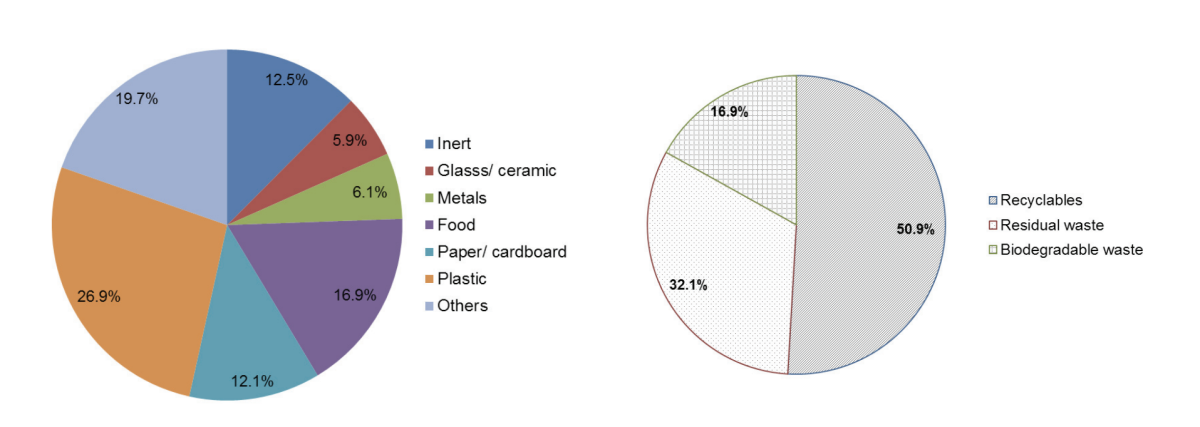
Source: CPCB 2009
Food catering units are the main centres of solid waste generation at railway platforms. A large amount of recyclables, which are used for packaging food and beverages, also get generated as a result. Packaging waste includes paper, cardboard, glass bottles, metal cans and large amounts of various plastics (CPCB 2009). The National Academy of Indian Railways (NAIR) has already recommended that specific areas should be earmarked for maintaining cleanliness by vendors at train stations and failing to do so should invite heavy penalties. Additionally, providing separate storage for food waste, recyclables and disposable waste within their premises is the responsibility of vendors. Serious deliberations are required to minimise and prevent waste from food catering onboard trains. Measures could include the use of recycled materials or the use of biodegradable materials and proper labeling of all materials for their efficient segregation and recovery.
Most of the trains or coaches lack appropriate onboard facilities for disposal of waste generated by passengers’ activities. A large number of existing dustbins, including those at the train stations, lack polybags and shortfall of manpower for garbage handling are common concerns at many stations. Even if provisions for garbage bins exist inside trains, there are no provisions for separate collection of food waste and recyclables. One of the primary reasons for this is the lack of adequate and/or appropriate waste recycling infrastructure at railway stations. Audit reports from 2007 and 2014 highlight the lack of any mechanisms to handle large quantities of waste within the railways (PAC 2015).
Under the “Swachh Rail Swachh Bharat Mission”, Indian Railways notified detailed instructions in 2015 to its zonal authorities for implementing waste segregation. Three differently coloured refuse bins need to be maintained as per these instructions: Green (for Bio-degradable waste), White (for recyclable waste) and Black (all other waste) of sufficient size to ensure 100% collection (IR 2015b). This applies to all catering units and for garbage collection inside trains. Also, the role of Service Improvement Groups (SIGs) has been reemphasized for intensifying cleaning activities at all major railway stations categorized as ‘A’ or ‘A1’(IR 2016). Table 1 outlines the waste segregation requirements at major stations, based on passenger footfall per day and nature of waste generated. It is estimated that the white bins (recyclable waste) would be required in the maximum quantity (50%) whereas there would be roughly similar requirements for green and black bins.
Table 1. Requirement of Segregation Infrastructure at Various Railway Stations as per the SWM Rules 2016

Source: Adapted from CPCB 2009 and Indian Railways Statistics 2011-12
Currently, due to lack of segregation, waste from railway stations either gets dumped along with the municipal waste or concerned railway authorities frequently resort to improper disposal of waste by burning, dumping into adjacent canals, low lying areas, and near the track, causing environmental pollution (NAIR 2015). Waste generated within the trains also gets evacuated while trains are stationary and it is therefore extremely important that there is emphasis on the development of segregation and recycling infrastructure around railway stations. The Indian Railways has traditionally been dependent on the municipal waste management system to evacuate its waste and already overburdened municipal systems have exacerbated the challenge. The development of decentralised waste management infrastructure is, therefore, essential if IR is to move towards sustainable practices. Lack of modern and mechanised approaches towards station cleanliness has been particularly challenging at small stations (NAIR 2015).
As outlined in Figure 3 below, the waste management process should be considered for decision making to choose among different strategies for managing solid waste economically. Preventing/ minimising waste at source has significant potential to avoid waste and in reducing the cost of managing it. This most often requires radical change in the way services are provisioned. For instance, water ATMs can eliminate the generation of PET waste from packaged drinking water. Direct reuse is preferable over material recycling/ recovery as it would avoid the cost of transporting materials to recycling facilities and subsequently, reduce the fuel requirements for re-manufacturing the product. At the other extreme, landfilling should be considered as the last option for disposal of the bare minimum quantum of waste in an environmentally sustainable manner. Minimising generation of plastic waste at source has formed an important part of the IR recent strategy.
Figure 3. Process of Waste Management Strategies for Sustainability in Waste Management Operations

Source: CEEW 2016
The only major field based study for waste generation and characterisation at railway stations was undertaken by RITES in 2009 for three major stations in Delhi, namely Hazrat Nizamuddin (HNZM), Old Delhi (DLI) and New Delhi (NDLS) Railway Stations. The total quantity of waste generated at these three railway stations was found to be 25 TPD, which included plastics amounting to 7 TPD (CPCB 2009). About 20%-32% of these plastics (roughly 2 tonnes) originated from PET bottles for drinking water and beverages (Figure 4). There were 235 ragpickers and 28 recycling dealers who were active around these railways stations and collected such value added plastics and contributed to directing these plastics for recycling. The remaining waste was mixed and transported by IR every day to be disposed at city landfills. It can be deduced from this study that on average one railway passenger contributes to roughly 65 grams of waste. Also, the present extent of recycling across railways is 8% and as highlighted earlier, there is potential of more than 50% recycling across IR (Figure 1).
Figure 4. Waste Characteristics at Three Railway Stations of Delhi

Source: CPCB 2009 and IR Statistics 2011-2012
Waste-to-Energy Potential
The food waste generated at railway stations and onboard trains presents a significant opportunity for energy recovery and composting. The former is especially relevant for stations with a large waste footprint because energy recovery (in the form of biogas) becomes economically feasible at capacities above 1 TPD (Hulgaard 2015; PC 2014). Anaerobic digestion (AD) has long been used for sewage sludge or livestock waste in rural settings. But operational challenges are very high for solid waste due to the non-homogenous nature and high solid contents of municipal solid waste (UNEP and ISWA 2015).
Technology comes in varying configurations and types. In an optimised system, methane content of biogas could be as high as 50% and biogas generation varies from 70-90 m3 per tonne of organic waste (Hulgaard 2015; PC 2014). Segregation is an important prerequisite for successful implementation of WtE projects as contamination with other waste and impurities significantly undermine the efficiency of the energy recovery process (Kumar and Sil 2015). Estimates for the WtE potential across major railway stations (based on passengers received daily at these stations) in the country are presented in Table 2, it was estimated that the energy recovery potential in these stations is around 17.6 MWh (biogas). Also, the requirements for separate storage of organic waste are presented, which is estimated to be around 776 bins of 100 litres capacity each. Decentalised WtE for biodegradable waste has significant co-benefits. It would reduce the trasnportation costs for IR for shifting the waste to the nearest landfill sites operated by the city authorities, by almost 15-25%. Also, it has huge enviornmental benefits of avoided land/ groundwater pollution (from leachate formation at landfill sites) and avoided GHG emissions at landfill sites. An important byproduct of AD is solid digestate, which could be used as soil conditioner or organic fetriliser after a period of aerobic stabilisation.
Table 2. Decentralised Waste-to-Energy Potential at Major Railway Stations
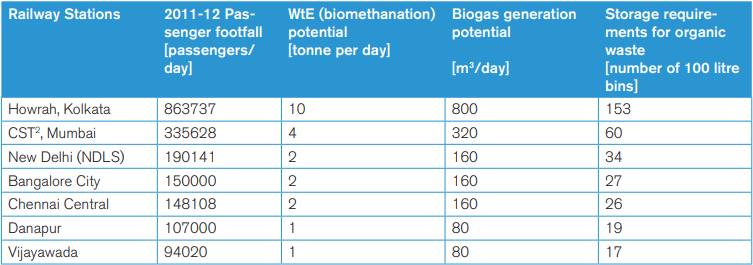
Source: Adapted from CPCB 2009 and Indian Railways Statistics 2011-12
The Ministry of Environment, Forests and Climate Change (MoEFCC) notified new waste management rules (S.O. 1357(E)) in April 2016 under the Environment (Protection) Act, 1986. These rules replaced the existing Municipal Solid Waste Management Rules 2000 and now extend beyond the jurisdiction of municipal bodies to cover census towns, ports/ harbours, defense establishments, SEZs, airports etc. including all the areas under the Indian Railways (MoEFCC 2016). These rules will have following implications for IR-
IR has traditionally used “open discharge” type toilet systems. Approximately 4,000 tonnes of human waste per day is dumped through ‘open discharge’ type toilets, that directly goes onto the rail tracks across the country (NAIR 2015). In addition, toilet discharges are the primary cause of corrosion of railway tracks (PAC 2014). Preventing use of “open discharge” type toilets at stations has been a challenging task for the Railways. To solve these challenges, bio-toilets were developed by the Railways in collaboration with the Defense Research and Development Organisation (DRDO) and are increasingly being adopted in rail coaches. A stainless steel biotoilet set with six chambers costs about INR 90,000 (NAIR 2015).It is fitted beneath each of the four rest rooms in a train coach and by 2016-17 all new trains will have bio-toilets. These biotoilets break down faeces into methane and portable odourless liquid, using anaerobic bacterial cultures. At relatively bigger train stations, faecal flow from trains is usually directed to the open drains adjacent to the train tracks using water-jets. This together with the sewage fl ow from stationary toilets flows into the municipal wastewater sewerage system.
Controlled discharge type toilets, which release faecal fl ow once the train reaches a predetermined speed (40km/hr), are used on modern Linke Hofmann Busch (LBH) coaches. This helps to keep the stations and train yards free of toilet discharge. But such systems have a higher cost, approximately INR 7.5 lakh per coach.
Other types of toilets that are being piloted by the railways include vacuum toilets, which can increase water-use effi ciency onboard trains. Water consumption in these toilets is minimal with maximum of 0.8 litre water requirement per fl ush (NAIR 2015). The sewage is collected in an underframe retention tank. Chemical treatment is used to promote coagulation and disinfecting organic matter. Solidifi ed sludge is removed during routine cleaning of coaches. At the stations, IR has also taken initiatives to bring more and more toilets under the purview of ‘Pay & Use’ toilets, which could help reduce the fi scal burden on IR and help keep the toilets clean. This includes several deluxe toilets at major stations. At present, more than 850 stations are provided with normal ‘Pay & Use’ toilets and more than 30 stations are provided with Deluxe ‘Pay & Use’ toilets on Indian Railways (NAIR 2015).
IR is probably the third largest consumer of water after agriculture and the power sector (Press Information Bureau, 2015). Unfortunately, the Railways do not maintain a centralised database on its water use across its Zones and Production Units (Nair, 2016). Independent estimates, either through interviews or RTI petitions, have brought some light on the extent of water use in the Railways.
For instance, Western Railways’ Mumbai suburban section, which is spread over 465 km, operating 2,342 train services and catering to more than 7.5 million commuters daily, consumes about 22.11 million litres of water each day (Nair, 2016). Moreover, for cleaning one rake (22- 24 coaches) alone, about 12,000 to 14,000 litres of water is required (Press Trust of India, 2016), whereas, the installation of Automatic Coach Washing Plant could halve the water requirement to 6000 litres per rake. The Railways are found to depend largely on groundwater for their daily water needs (Press Trust of India, 2016). For instance, the IR Delhi zone extracted 1.44 million litres of water from 15 tube wells located in the railway colonies around the city. It was used for domestic purposes in eight colonies of Delhi and also for cleaning coaches (Jain, 2014). This practice should be immediately checked as Delhi is importing water from other states and treated wastewater should be used for cleaning purposes.
Moreover, the Railways are also affected by signifi cant water leakages. Anecdotal instances, expressed by passengers at the Chennai Egmore railway station, revealed “at least 4-5 taps leaking and water fl owing in the tracks or platforms for hours together” (Narayanan, 2015). At the Moradabad railway station, which is a major station with over 160 trains passing everyday, 6.66 million litres of water were being wasted every month because of leakages or unauthorised use from hydrants installed at the station (Brara, 2013).
The sanitation and wastewater management in the IR is improper thus aggravating the water and environment related challenges. The Comptroller and Auditor General report on ‘Cleanliness and Sanitation on IR’ has underlined that IR is fi nding hard to deal with problems like dilapidated drains, faulty design, incorrect gradients that lead to water stagnation and leaching (Hedaoo et al., 2012). Open discharge from railway coaches leads to surface and ground water contamination through runoff and leaching (GOI Monitor, 2013).
In order to treat the huge amount of sanitary waste and wastewater being generated and to address the issue of water scarcity through reuse of treated wastewater, the installation of sewage treatment plants have often been proposed. The Ministry of Water Resources, River Development & Ganga Rejuvenation also signed a MoU for setting up Water Recycling Plants at major water consumption centres. The MoU also emphasised the Railway Ministry’s will to augment reuse of treated water for non-potable purposes (Press Information Bureau, 2015).
The Ministry of Railways informed that rain water harvesting facilities have already been installed at 2060 locations and for 130 more locations for installation of rain water harvesting facilities have been approved (Press Information Bureau, 2015).
IR has decided to set up automatic coach washing plants at 10 major depots to save water required for cleaning trains. The proposed Automatic Coach Washing Plant, once installed, would require only 6000 litres to clean a rake out of which 4000 litres would be recycled water (Press Trust of India, 2016).
The North Western Railways have restored an architectural open well situated near the Isarda railway station in Tonk district, which falls on the Jaipur-Sawai Madhopur rail route. The restored well can discharge 5,000 litres per hour, which is used for cleaning the station, as drinking water supply for about 10 railways quarters in the nearby railway colony, and other purposes (Singh, 2016).
The rain harvesting project introduced by Central Railway at Lokmanya Tilak Terminus will help to cater for 40% of the daily requirement of 1.8 million litres, which would help to save INR 12 lakh per month or INR 1.44 crore annually (Sen, 2015).
In order to improve the situation of water management in the IR, it is important to protect contamination of water source by ensuring proper solid, faecal waste and wastewater management. Wastewater that has been treated should be reused to augment water supply for non-potable purposes like landscaping, cleaning of coaches and fl ushing. The dependence on existing surface/ ground water sources should also be decreased by installing capacity for rainwater harvesting. While supply side augmentation is essential, IR needs to put concentrated effort for improving water use effi ciency. Installing water-saving devices like water effi cient urinals, toilets, faucets and automatic coach washing plants could save huge amount of water. Leaks should be detected and repaired on a regular basis. A research study on resources use effi ciency suggest that there exists a water saving potential of around 71% if the above discussed measures are adopted (TERI, 2012).
Monitoring of water use is of utmost importance in order to increase water use effi ciency. Systems to improve monitoring of water like installation of water meters and SCADA system is recommended. It is also important to maintain a centralised database of water use. Emphasis should be given for regulatory compliance of water use and water quality standard in order to prevent public nuisance and environmental damage.
The Indian Railways needs a comprehensive strategy for management of waste requiring efforts at different levels. To create an enabling environment, it should simultaneously leverage existing regulations, fi nd synergies with national missions/policies, restructure existing institutional arrangements or create new institutions, wherever required.
In keeping with the spirit of the New Environment Policy (2006) and its idea that environment protection shall form an integral part of the developmental process, the establishment of the Environment Directorate at the Railway Board level to coordinate various environmental issues involved in their operations, further establishes its commitment towards environmental protection. To ensure effective implementation and achievement of goals, the Indian Railways needs to formulate a ‘Comprehensive Environmental Management Plan’ (CEMP) that includes waste management, enhanced resource use effi ciency, energy management and controlling of air and water pollution.
It is recommended that pilot studies with regards to resource use and waste management across the railways are undertaken. These should be carried out for sampled stations which are spatially distributed across the country and include both suburban and non-suburban stations, which would have varying resource use patterns and waste characteristics.
The Railways should prepare a detailed strategy, in consultation with sectoral experts, for diverting 67% solid waste which ends up in landfi lls due to absence of recycling and treatment. This strategy should clearly highlight the roles and responsibilities of offi cials at the zonal and divisional levels.
It is also recommended that the Indian Railways should track the progress made under various interventions in order to measure their impact. This will provide concrete evidence and therefore a positive reinforcement to ongoing programmes and interventions for a widespread demonstration and deployment of better waste management practices through the quantifi cation of their benefi ts.
Last but not the least, given the scale of the issue of waste management, it would require signifi cant coordination and support from different stakeholders. A joint committee comprising of experts from the Railways, Ministry of Urban Development, Pollution Control Boards and civil society could be formed to regularly review and suggest necessary action points for the effective implementation of interventions.
1 402 major stations which are categories as A1 or A by IR based on revenue generation from these stations
2 Non-recyclable stream of waste having a calorific value of more than 1500 kCal are banned (21) for disposal at dumpsites
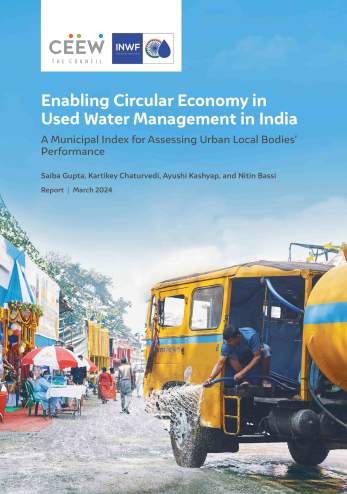
Enabling Circular Economy in Used Water Management in India
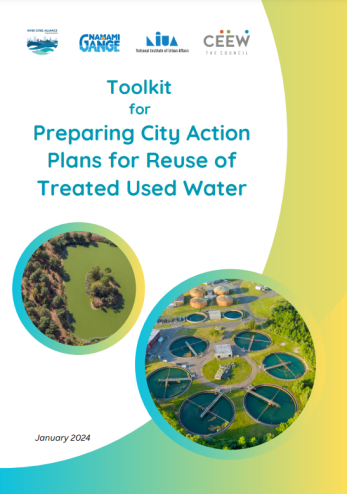
Toolkit for "Preparing City Action Plans for Reuse of Treated Used Water"
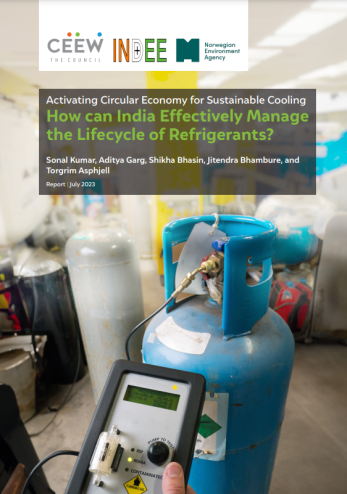
Activating Circular Economy for Sustainable Cooling
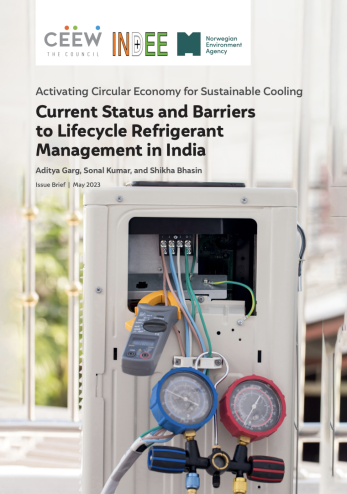
Activating Circular Economy for Sustainable Cooling
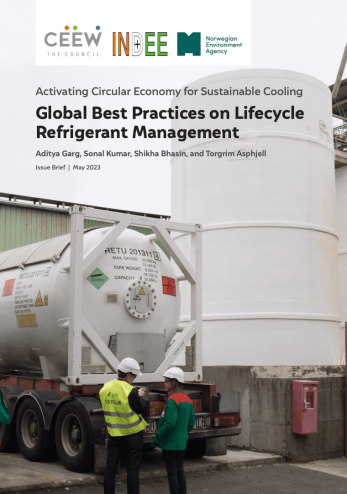
Activating Circular Economy for Sustainable Cooling